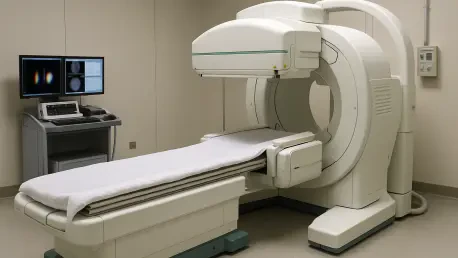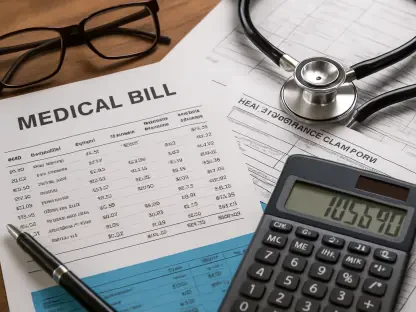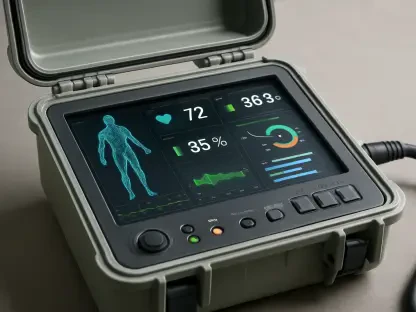Nuclear medicine stands as a beacon of hope for countless patients, offering cutting-edge diagnostics and treatments for life-threatening conditions such as cancer and cardiovascular disease, yet it harbors a lesser-known peril that demands urgent attention. This peril is the extravasation of radiopharmaceuticals—a mishap where these potent substances, intended for intravenous delivery, inadvertently seep into surrounding tissue, exposing healthy cells to potentially harmful levels of radiation. For far too long, a regulatory gap within the Nuclear Regulatory Commission (NRC) framework has allowed these incidents to evade mandatory reporting, leaving patients uninformed and obstructing critical safety enhancements. Enter H.R.2541, known as the Nuclear Medicine Clarification Act, a legislative proposal designed to mandate the documentation of significant extravasations, promising a transformative shift toward greater patient protection. This issue transcends mere technical oversight; it strikes at the core of trust and transparency in healthcare. Imagine a scenario where a patient undergoes a critical scan or therapy, unaware that an error has occurred—one that might impact their well-being years later—yet no disclosure follows. Such is the reality under a decades-old policy that has failed to evolve with scientific advancements. With modern techniques and training rendering many of these incidents preventable, the persistence of this reporting exemption is indefensible. This article delves into the compelling reasons behind the necessity of this legislation, exploring the hidden risks of extravasations, the outdated regulations perpetuating the problem, and the broader implications for patient safety and medical integrity.
Unveiling the Risks of Radiopharmaceutical Extravasations
The frequency of extravasations in nuclear medicine is alarmingly high, with research indicating a rate surpassing 17% when injection sites are meticulously monitored. Unlike chemotherapy agents that cause immediate pain or visible swelling upon leakage, radiopharmaceuticals involve tiny volumes that often go undetected by both patients and clinicians. Despite the lack of overt symptoms, the radiation dose delivered to a small tissue area can be immense, sometimes rivaling years of natural background exposure within mere hours. This hidden threat underscores the urgency of recognizing and addressing these incidents systematically, as their invisibility does not equate to harmlessness.
Moreover, the consequences of extravasations extend beyond immediate health concerns, posing a risk of delayed damage that can manifest over time. A minor leak of a radiopharmaceutical like 18F-FDG can expose tissue to doses as high as 9.1 Gray, a level capable of inducing cellular harm that might remain dormant for months or even years. Particularly vulnerable are younger patients who may undergo multiple procedures throughout their lives, accumulating radiation exposure that heightens the likelihood of long-term complications. This potential for future harm emphasizes the critical need for documentation and follow-up, which current exemptions hinder by allowing these events to remain unrecorded and unaddressed.
Additionally, the impact of extravasations on medical outcomes cannot be overstated, as they jeopardize the very purpose of nuclear medicine procedures. When radiopharmaceuticals fail to reach their intended vascular targets, diagnostic imaging can yield misleading results, and therapeutic interventions may lose their efficacy. This dual threat to patient safety and procedural accuracy highlights a pressing issue that demands intervention. Without mandatory reporting, there is little incentive or mechanism to track these errors, leaving the field of nuclear medicine vulnerable to repeated mistakes that could be mitigated through awareness and corrective action.
Exposing Flaws in Current NRC Regulations
The roots of the extravasation reporting exemption trace back to 1980, when the NRC deemed such incidents an unavoidable aspect of nuclear medicine, reflecting the limited technological capabilities of that era. However, advancements in medical practices and tools have since rendered this assumption obsolete, with over 100 peer-reviewed studies demonstrating both the risks associated with extravasations and the feasibility of prevention. Despite this wealth of evidence, the exemption persists, creating a perplexing inconsistency in regulatory standards for radiation exposure. This outdated policy fails to align with the current understanding of safety and accountability in healthcare.
In stark contrast to the handling of other radiation mishaps, the NRC mandates reporting for incidents like a radioactive spill on a patient’s skin if the dose exceeds 0.5 Sievert, yet an extravasation delivering a far greater dose to tissue escapes such scrutiny. This double standard has drawn sharp criticism from experts and patient advocates who argue that all unintended exposures should be subject to equivalent oversight. The failure to update this policy not only undermines patient safety but also erodes confidence in the regulatory framework meant to protect public health.
Efforts to rectify this issue have met with resistance, as evidenced by the NRC’s slow response to advocacy for change, including a notable petition submitted in 2020. Even with acknowledgment of the problem, the proposed rule in the current year introduces subjective criteria for reporting—only if a clinician perceives patient harm—potentially allowing bias to undermine accountability. H.R.2541 emerges as a necessary corrective measure, aiming to enforce mandatory reporting of significant extravasations and ensure that transparency is not left to discretionary judgment, thereby addressing a long-standing regulatory shortfall.
Championing Patient Rights and Transparency
Central to the debate surrounding extravasations is the fundamental right of patients to be informed about their medical care, particularly when errors occur. Often, individuals undergoing nuclear medicine procedures remain unaware that an extravasation has taken place, despite the unintended radiation exposure to their tissues. Patient advocates have voiced frustration over this lack of disclosure, questioning why such incidents are not openly communicated. This opacity not only violates trust but also deprives patients of the opportunity to understand potential risks to their health.
Furthermore, mandatory reporting serves a broader purpose beyond individual notification; it facilitates systemic learning and improvement within the medical community. Documenting extravasations allows for the identification of recurring issues, whether tied to specific techniques, equipment, or training deficiencies. Such data can drive targeted interventions to prevent future occurrences, enhancing overall safety standards. Without a mechanism to capture and analyze these events, the cycle of error persists, placing additional patients at risk unnecessarily.
The ethical imperative of transparency cannot be ignored in this context. Patients are entitled to be active participants in discussions about their health, especially when something goes awry during treatment. By mandating the reporting of significant extravasations, H.R.2541 would ensure that critical information is shared, empowering individuals while compelling healthcare providers to prioritize safety over the convenience of silence. This shift toward openness is essential for rebuilding trust and fostering a patient-centered approach in nuclear medicine.
Proving Extravasations Can Be Prevented
A compelling argument for the passage of H.R.2541 lies in the demonstrable preventability of extravasations, challenging the historical notion that they are an inevitable part of nuclear medicine. Comparative analysis with fields like CT imaging and chemotherapy reveals a striking disparity—extravasation rates in those areas are as low as 1-2 per thousand due to rigorous monitoring and quality protocols, while nuclear medicine reports a rate closer to 172 per thousand. This gap signals a clear opportunity for improvement through the adoption of established best practices.
Evidence from within the field further bolsters this case, as several nuclear medicine centers have successfully reduced extravasation rates within months by implementing monitoring technologies and enhancing staff training on injection techniques. These initiatives illustrate that with focused effort and commitment, the frequency of such incidents can be significantly diminished. The success of these programs serves as a blueprint for broader application across the industry, demonstrating that change is not only possible but also achievable in a short timeframe.
H.R.2541’s mandate for reporting would act as a catalyst for widespread adoption of these preventive measures. Facilities already maintaining low extravasation rates would face minimal additional workload, while those with higher incidences would be incentivized to improve their practices to avoid scrutiny. This legislative push ensures that patient safety does not vary based on the location of treatment, creating a uniform standard that prioritizes consistent quality and accountability across all nuclear medicine providers.
Highlighting Economic and Clinical Consequences
The financial implications of unreported extravasations present a significant concern that extends beyond individual patient outcomes to the broader healthcare system. Radiopharmaceuticals carry substantial costs, with diagnostic agents guiding treatments worth hundreds of thousands of dollars and therapeutic doses reaching up to $50,000 per administration. When an extravasation disrupts these procedures, it results in a wasteful expenditure of resources, impacting both providers and payers who bear the burden of ineffective treatments or repeated interventions.
Clinically, the stakes are equally critical, as nuclear medicine depends on precision for reliable outcomes. Healthcare professionals invest considerable effort in calibrating equipment and optimizing protocols to ensure accuracy, yet an extravasation at the point of injection can unravel these efforts. Such mishaps can distort imaging results, leading to potential misdiagnoses, or diminish the effectiveness of therapeutic applications, compromising patient care. This vulnerability at a fundamental stage of the process demands attention to prevent undermining the field’s credibility.
By enforcing the documentation of extravasations, H.R.2541 would illuminate these costly errors, encouraging investment in prevention strategies that safeguard both financial and clinical interests. The legislation is not merely a protective measure for patients but also a means to preserve the integrity of nuclear medicine practices. Addressing these incidents head-on ensures that the substantial resources devoted to this field yield the intended benefits, reinforcing the value of every procedure conducted.
Dismantling Concerns Over Reporting Obligations
Opposition to H.R.2541 often centers on the perceived burden that mandatory reporting would place on nuclear medicine facilities, with some arguing it would create unnecessary administrative strain. However, practical evidence from centers that monitor thousands of injections annually contradicts this view. Experts in the field have reported no significant workload increase, and accessible tools, such as free software developed by academic institutions, enable rapid assessment of extravasations in under five minutes, dispelling notions of excessive complexity.
For facilities with low rates of extravasation, the reporting requirement would be an infrequent task, posing little disruption to daily operations. Conversely, for those experiencing frequent incidents, the obligation to report serves as a necessary prompt to address underlying issues, whether through training or procedural adjustments. Far from being a punitive measure, this requirement acts as a mechanism to elevate standards, ensuring that patient safety takes precedence over reluctance to engage with documentation.
The argument against reporting often stems from a resistance to accountability rather than a grounded concern over feasibility. When weighed against the potential harm of unaddressed radiation exposure, the administrative effort pales in comparison. H.R.2541 shifts the focus back to the core priority of patient well-being, ensuring that procedural oversights are not dismissed under the guise of operational inconvenience but are instead treated as opportunities for meaningful improvement.
Addressing Long-Term Health Implications
One of the most concerning aspects of extravasations is the potential for delayed health consequences, as radiation damage does not always manifest immediately. Critics may downplay the severity of these incidents due to the absence of instant pain or visible effects, but the reality is that high doses delivered to localized tissue can lead to complications years later. This risk is particularly pronounced for younger patients who may face cumulative exposures over multiple treatments, necessitating vigilant long-term monitoring.
Even the natural reabsorption of extravasated material by the body does not fully mitigate the danger, as significant radiation exposure occurs before clearance through the lymphatic system. During this process, additional tissues may be inadvertently irradiated, compounding the unintended impact. This delayed and dispersed effect underscores the importance of identifying and documenting extravasations at the outset to enable appropriate follow-up care, a step that current exemptions render nearly impossible.
H.R.2541 offers a solution by ensuring these incidents are recorded, paving the way for sustained observation of affected patients. Such documentation creates a framework for healthcare providers to track potential issues before they escalate into serious conditions, offering a proactive approach to safeguarding health. By closing the reporting gap, this legislation addresses not only immediate safety concerns but also the enduring implications of radiation mishaps, protecting future well-being through informed and systematic care.
Paving the Way for a Safer Future in Nuclear Medicine
Reflecting on the extensive challenges posed by unreported extravasations, it becomes evident that action through H.R.2541 is a pivotal step to address a long-standing oversight in nuclear medicine. The legislation tackles the hidden risks of radiation exposure, the outdated regulatory exemptions, and the ethical lapse in patient transparency, setting a new standard for accountability. It responds to decades of evidence that demand change, ensuring that patient safety is no longer compromised by silence or inaction.
Looking ahead, the path forward involves sustained commitment from healthcare facilities to integrate robust monitoring and prevention strategies, building on the mandate to report significant incidents. Collaboration between regulators, providers, and technology developers can further refine tools and training, reducing extravasation rates to match those of other medical fields. This collective effort promises to enhance procedural accuracy and protect patient trust, reinforcing nuclear medicine as a cornerstone of modern healthcare.
Moreover, the focus must extend to educating patients about their rights and the importance of transparency, empowering them to advocate for their own care. Establishing national registries to track and analyze extravasation data could also provide invaluable insights, driving continuous improvement across the industry. As these steps unfold, the legacy of H.R.2541 will be measured by its ability to foster a culture of safety and responsibility, ensuring that past oversights become lessons for a more secure and reliable future in medical innovation.









